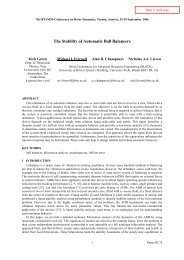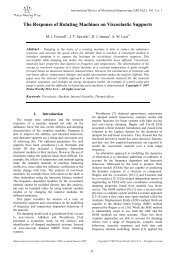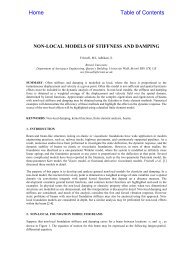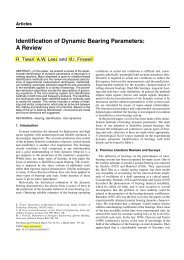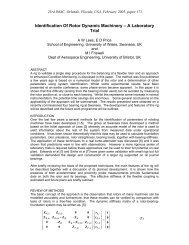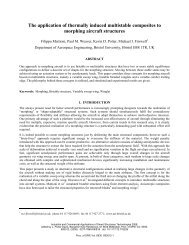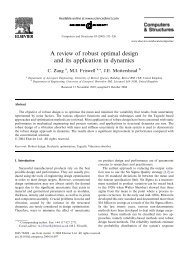Optimal Design of Elastomer Composites for ... - Michael I Friswell
Optimal Design of Elastomer Composites for ... - Michael I Friswell
Optimal Design of Elastomer Composites for ... - Michael I Friswell
You also want an ePaper? Increase the reach of your titles
YUMPU automatically turns print PDFs into web optimized ePapers that Google loves.
elastomers are the major parameters in designing the FRE<br />
lamina <strong>for</strong> morphing skins and have to be investigated.<br />
2. The out-<strong>of</strong>-plane deflection <strong>of</strong> the plate varies considerably<br />
with the aspect ratio and boundary conditions as the mode<br />
<strong>of</strong> deflection varies. There<strong>for</strong>e, the optimal distribution <strong>of</strong><br />
volume fraction <strong>of</strong> fiber varies with the aspect ratio <strong>of</strong> the<br />
plate.<br />
3. The optimization per<strong>for</strong>med to minimize the out-<strong>of</strong>-plane<br />
deflection shows that the parabolic type fiber distributions<br />
increase the bending stiffness. The optimal distribution <strong>of</strong><br />
fibers minimizes the out-<strong>of</strong>-plane deflection by 25 to 30%<br />
compared to the uni<strong>for</strong>m fiber distribution.<br />
4. The optimization per<strong>for</strong>med to increase the flexibility ratio<br />
<strong>of</strong> the laminate has shown that the non-uni<strong>for</strong>m distribution<br />
<strong>of</strong> fibers increases the flexibility ratio by almost 30-47%<br />
over that <strong>for</strong> a uni<strong>for</strong>m distribution <strong>of</strong> fibers. The flexibility<br />
ratio <strong>of</strong> optimal fiber distributions with an average volume<br />
fraction <strong>of</strong> 40% is higher than the uni<strong>for</strong>m fiber distribution<br />
with a volume fraction <strong>of</strong> 60%.<br />
These results clearly show that the variable fiber distribution<br />
plays a major role in enhancing the desirable characteristics <strong>of</strong><br />
morphing skins modeled as composite laminates.<br />
ACKNOWLEDGMENT<br />
The authors acknowledge the support <strong>of</strong> the European Research<br />
Council through project 247045 entitled ”Optimisation <strong>of</strong><br />
Multi-scale Structures with Applications to Morphing Aircraft”.<br />
REFERENCES<br />
[1] Olympio, K. R., and Gandhi, F., 2010. “Zero poisson’s<br />
ratio cellular honeycombs <strong>for</strong> flex skins undergoing onedimensional<br />
morphing”. Journal <strong>of</strong> Intelligent Materials<br />
Systems and Structures, 21(17), NOV, pp. 1737–1753.<br />
[2] Bubert, E. A., 2009. “Highly extensible skin <strong>for</strong> a variable<br />
wing-span morphing aircraft utilizing pneumatic artificial<br />
muscle actuation”. MS Thesis, University <strong>of</strong> Maryland,<br />
College Park.<br />
[3] Peel, L. D., Mejia, J., Narvaez, B., Thompson, K., and Lingala,<br />
M., 2009. “Development <strong>of</strong> a simple morphing wing<br />
using elastomeric composites as skins and actuators”. Journal<br />
<strong>of</strong> Mechanical <strong>Design</strong>, 131(9), p. 091003.<br />
[4] Kikuta, M. T., 2009. “Mechanical Properties <strong>of</strong> Candidate<br />
Materials <strong>for</strong> Morphing Wings”. MS Thesis, Virginia Polytechnic<br />
Institute and State University, Blacksburg, Virginia.<br />
[5] Grdal, Z., Tatting, B., and Wu, C., 2008. “Variable stiffness<br />
composite panels: Effects <strong>of</strong> stiffness variation on the inplane<br />
and buckling response”. <strong>Composites</strong> Part A: Applied<br />
Science and Manufacturing, 39(5), pp. 911 – 922.<br />
[6] Leissa, A., and Martin, A., 1990. “Vibration and buckling<br />
<strong>of</strong> rectangular composite plates with variable fiber spacing”.<br />
Composite Structures, 14(4), pp. 339 – 357.<br />
[7] Benatta, M., Mechab, I., Tounsi, A., and Bedia, E. A., 2008.<br />
“Static analysis <strong>of</strong> functionally graded short beams including<br />
warping and shear de<strong>for</strong>mation effects”. Computational<br />
Materials Science, 44(2), pp. 765 – 773.<br />
[8] Kuo, S.-Y., and Shiau, L.-C., 2009. “Buckling and vibration<br />
<strong>of</strong> composite laminated plates with variable fiber spacing”.<br />
Composite Structures, 90(2), pp. 196 – 200.<br />
[9] Wolfe, W. E., and Butalia, T. S., 1998. “A strain-energy<br />
based failure criterion <strong>for</strong> non-linear analysis <strong>of</strong> composite<br />
laminates subjected to biaxial loading”. <strong>Composites</strong> Science<br />
and Technology, 58(7), pp. 1107 – 1124.<br />
[10] Ochoa, O. O., and Reddy, J. N., 1992. Finite Element Analysis<br />
<strong>of</strong> Composite Laminates. Kluwer Academic Publishers,<br />
Dordrecht.<br />
[11] Peel, L. D., 2007. “Exploration <strong>of</strong> high and negative poissons<br />
ratio elastomer-matrix laminates”. Physica Status Solidi<br />
(b), 244(3), pp. 988–1003.<br />
[12] ANSYS, 2007. Release 11.0 Documentation <strong>for</strong> ANSYS.<br />
ANSYS, Inc., Southpointe, Canonsburg, PA 15317.<br />
[13] Giusti, S. M., Blanco, P. J., de Souza Neto, E. A., and<br />
Feijóo, R. A., 2009. “An assessment <strong>of</strong> the gurson yield<br />
criterion by a computational multi-scale approach”. Engineering<br />
Computations, 26(3), pp. 281–301.<br />
[14] Saavedra Flores, E. I., and de Souza Neto, E. A., 2010.<br />
“Remarks on symmetry conditions in computational homogenisation<br />
problems”. Engineering Computations,<br />
27(4), pp. 551–575.<br />
[15] Bowen, C. R., Dent, A. C., Nelson, L. J., Stevens, R., Cain,<br />
M. G., and Stewart, M., 2006. “Failure and volume fraction<br />
dependent mechanical properties <strong>of</strong> composite sensors<br />
and actuators”. Proc. IMechE Vol. Part C: J. Mechanical<br />
Engineering Science, 220(C11), pp. 1655–1664.<br />
[16] Murugan, M., Suresh, S., Ganguli, R., and Mani, V., 2007.<br />
“Target vector optimization <strong>of</strong> composite box beam using<br />
real-coded genetic algorithm: a decomposition approach”.<br />
Structural and Multidisciplinary Optimization,<br />
33, pp. 131–146. 10.1007/s00158-006-0030-1.<br />
10 Copyright c⃝ 2011 by ASME




